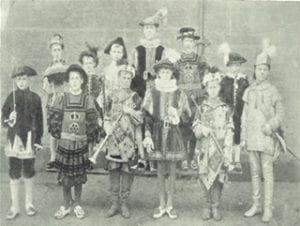
History of the Bo’ness Fair Day 3
The morn’s the Fair and I’’ll be there, and I’ll hae up ma curly hair. I’ll meet ma lad at the fit o’ the stair, an’ I’ll gie him dram and a wee bit mair.
Wednesday 17th June 2020
In 1898 the second Crowning was held in front of Kinneil House. After the crowning the revels were held in the adjacent Brewlands Park. In 1974 the stables were converted into Kinneil Museum and the china mugs used to give the children a refreshment was found still packed in wicket baskets in the loft. [Wonder where they are now.]
This must have been very colourful affairs, for all the children, both boys and girls, wore scarlet, blue and yellow caps, according to their school colours and all the little girls were dressed in their new white Fair dresses, while the little boys were all turned out in white flannel shorts and white shirts. For the children, there was an added touch of excitement about the Fair because it always marked the start of the school holidays and that the long hot summer weeks of freedom lay ahead.
“The morn’s the Fair and I’ll be there, And I’ll hae up my curlie hair,”
chanted the little Bo’ness girls as they raced home from school on the Fair E’en to gaze yet again at the new white dresses and shoes, which they would wear for the first time the following morning.
Crowning in the Band Stand
The Band stand in the Glebe park was supplied by Walter McFarlane’s Saracen Works in Glasgow, the commissionaires having chosen the design from McFarlane’s catalogue. From the terminal at the top, the slated roof, spandrels, columns and the basic design could be adapted to form a bandstand, pavilion, summerhouse, arbour or kiosk. The Burgh Commissioners had acquired the ground in 1894 and in 1900 opened it as a public park. At this time the Town Hall was still on the drawing board. The bandstand’s inaugural programme on Wednesday 14th August 1901, was not without difficulty. The town had two bands, Bo’ness and Carriden Band and Kinneil Band, and although they agreed to open the evening by playing the National Anthem together, neither wanted to play ‘second fiddle’ in the programme of music that followed. Who would play first? The town commissioner drew lots and Kinneil won. With reluctance the Bo’ness and Carriden Band’s men joined them.
The first serious interruption in the smooth running of the Fair occurred during the period of the First World War 1914-1918. On Friday 16th July 1915, when the first destroyer flotilla lay off Bo’ness it was possible to have a modest children’s procession to Ladywell Park beside Kinneil House. This was in conjunction with a Sports Day for the men of the Royal Navy under Captain Blunt, R.N. D.S.O. That was a Red-Letter Day in the history of the Burgh despite the fact that there was no crowning of a Fair Queen.
Linlithgowshire Gazette Friday 28th May 1919
After 4 years of War the Fair was revived in July 1919. Due to the post-war shortages there were no Fairies or school caps for the boys. There were difficulties over catering, while Councillor Angus Livingston campaigned for a shorter route for the procession.
Extract from the book – Without Fear
On 28th June 1919, the Treaty of Versailles was signed between Germany and the Allied Powers officially bringing World War One to an end. Perhaps the most important event to take place to confirm locally to Bo’nessians that peace had endured, and that things were returning to pre-war normality, was the recommencement of the Bo’ness Fair after a four-year hiatus.
On Friday, 18th July 1919, the children from the various schools attended the crowning ceremony of Queen Joan from Borrowstoun Public School in the Ladywell Park, Kinneil Estate. This time the summer sun was gleaming as the assembled crowd of at least 3000 people sang two verses of the Fair song “Our Festal Day” played by Kinneil Band.
For many of the residents of Bo’ness the effects of the Great War would take years to come to terms with. For those that had lost loved ones the wounds would take longer to heal. Many families had been devastated. More than 100 years later we cannot begin to imagine the grief and suffering, or the stoic resilience shown by those left behind. Families, friends and neighbours would rally round in support. The collateral experiences of the Great War helped to strengthen the community spirit still seen in Bo’ness to this day, culminating as always in our annual Fair festivities.
Read more tomorrow about the history of the Bo’ness Fair
The Arches and Procession
(Composed by Maria Ford)






